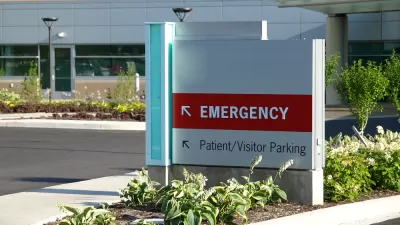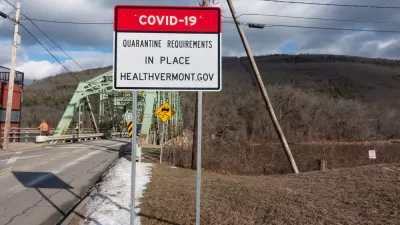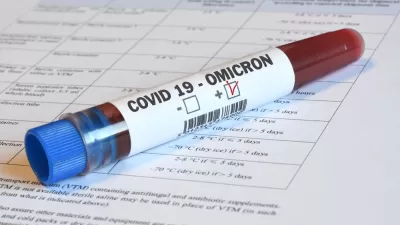Coronavirus cases and hospitalizations per capita in the District of Columbia are higher than in any state or U.S. territory on New Year's Day. Only Puerto Rico and Louisiana have seen hospitalizations increase faster than D.C. in the last two weeks.

The Washington Post explores possible causes for the District's exponential growth in cases, up 485% on New Year's Day from two weeks ago, according to The New York Times coronavirus tracker. However, it is the case incidence that sets the city apart from other regions as two territories ( U.S. Virgin Islands and Puerto Rico) and and five states (Florida, Louisiana, Georgia, Alabama, and Maryland) have seen cases increase by even higher percentages, respectively, during the same period.
"[T]here is no consensus on the answer to why the D.C. region is omicron’s leading hot spot," write Julie Zauzmer Weil, Rebecca Tan and Jenna Portnoy on Dec. 30, 2021.
Some hypothesized that the lack of a mask mandate in the city for a month — particularly at a time when the new variant was beginning to take hold — allowed the virus’s spread to accelerate.
COVID metrics
Cases – record highs
D.C., N.Y., N.J., Puerto Rico and Florida exceeded 200 daily cases per 100,000 residents on New Year's Day, according to the Times tracker, with 7-day averages of 298, 293, 268, 237 and 201 new cases per 100,000 residents, respectively. The nation is averaging almost 387,000 daily new cases or 117 per 100,000 residents.
The U.S. Virgin Islands and Puerto Rico saw the most explosive viral growth with rates exceeding 1,000% in the last 2 weeks. The increase in the U.S. is >200%.
Hospitalizations
The 7-day average of daily hospitalizations, i.e. patients in the hospital diagnosed with COVID-19, not to be confused with daily hospital admissions which the Centers for Disease Control and Prevention tracks, in the U.S. on Jan. 1 is 90,000, a 30% increase during the last 2 weeks. The hospitalization rate is 27 per 100,000 residents.
The District leads the country with 73 hospitalizations per 100,000 people (517 residents hospitalized on Jan. 1), +217% in the past 2 weeks. While Puerto Rico and Louisiana saw higher percentage increases, their hospitalization rates are below the national average.
Deaths
In sharp contrast to cases and hospitalizations, the death rates in Puerto Rico and D.C. are among the lowest in the nation. The 7-day daily average of Americans dying from COVID-19 on Jan. 1 is 1,239 or 0.37 deaths per 100,000 residents.
Alaska has the lowest death rate at 0.04, the District at 0.06, and Puerto Rico at 0.07 deaths per 100,000 residents. Wyoming, Guam, and American Samoa recorded no deaths during the last week.
Vaccinations
Sixty-two percent of the nation's population is fully vaccinated. In Maryland and D.C., it is 70% and 68%, the 10th and 12th highest in the country, respectively.
The last word goes to David Marcozzi, a professor and physician leading the Covid-19 response for the University of Maryland Medical System, who told The Washington Post:
“We’re presently in a perfect storm,” said Marcozzi. "While most people testing positive in recent weeks have been infected by the highly transmissible omicron variant, many of the those winding up in the hospital have the delta variant."
“The challenge here is that you have a virus that still transmits whether or not you’re vaccinated,” Marcozzi said. So even though a majority of Marylanders are immunized against the virus, he said, they’re able to carry and spread highly transmissible variants of the coronavirus that sicken those who aren’t adequately protected.
Related in Planetizen:
- Omicron Helps to Shatter Infection Records, Dec. 31, 2021
- Your Date With Omicron, Dec. 29, 2021
- 'A Tidal Wave of Omicron Coming,' December 16, 2021
- The Pandemic Crisis Is a Hospital Crisis, September 23, 2021
FULL STORY: D.C. had one of the lowest rates of coronavirus cases in the country. That has changed.

Planetizen Federal Action Tracker
A weekly monitor of how Trump’s orders and actions are impacting planners and planning in America.

Congressman Proposes Bill to Rename DC Metro “Trump Train”
The Make Autorail Great Again Act would withhold federal funding to the system until the Washington Metropolitan Area Transit Authority (WMATA), rebrands as the Washington Metropolitan Authority for Greater Access (WMAGA).

DARTSpace Platform Streamlines Dallas TOD Application Process
The Dallas transit agency hopes a shorter permitting timeline will boost transit-oriented development around rail stations.

Car-Centric LA Suburb Looks to a Train-Oriented Future
City leaders in Rancho Cucamonga, the future western terminus of the Brightline West rail line to Las Vegas, want to reimagine the city as a transit-oriented, pedestrian-friendly community.

New Alaska Bitcoin Mine Would Burn as Much Energy as the State’s Largest Coal Plant
Fueled by “stranded” natural gas, the startup hopes to become the largest in the US, and to make Alaska an industry center.

New Jersey Duplexes Elicit Mixed Reactions
Modern, two-unit residences are proliferating in northern New Jersey communities, signaling for some a boon to the housing supply and to others a loss of historic architecture.
Urban Design for Planners 1: Software Tools
This six-course series explores essential urban design concepts using open source software and equips planners with the tools they need to participate fully in the urban design process.
Planning for Universal Design
Learn the tools for implementing Universal Design in planning regulations.
Municipality of Princeton
Roanoke Valley-Alleghany Regional Commission
City of Mt Shasta
City of Camden Redevelopment Agency
City of Astoria
Transportation Research & Education Center (TREC) at Portland State University
US High Speed Rail Association
City of Camden Redevelopment Agency
Municipality of Princeton (NJ)





























